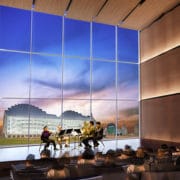UMKC releases studies of Downtown Arts Campus
A Downtown Campus for the Arts for the University of Missouri-Kansas City would improve educational opportunities for students in all fields, boost economic development for the region, enhance Kansas City’s ongoing arts renaissance and inject millions of dollars into the local economy over the next 25 years.
That is the conclusion of a series of studies commissioned by the university after a downtown arts campus was named one of the Big 5 goals for Greater Kansas City. These reports include a study of potential sites and costs, prepared by Helix Architecture + Design, Integra Realty Resources and HGA Architects and Engineers; an internal UMKC review of the potential impact of moving arts programs downtown on the university and its component parts; and an economic impact study conducted by the Mid-America Regional Council (MARC). The three studies, and a unified executive summary of all three, are available at http://info.umkc.edu/artscampus/impact-studies/
“When this idea was first broached, we had several fundamental questions we needed answered before we would move forward: Would it be better for the education of all of our students? Would it be good for the community? What would it cost?” said Leo E. Morton, UMKC Chancellor. “After reviewing these studies, we have our answers. We believe that this is the right thing to do, if the resources can be raised to make it happen.”
The sites and costs study recommends three potential sites and a phased move of the visual and performing arts schools over a 20+-year period. Under the “phasing” formula, the UMKC Conservatory of Music and Dance, which has the greatest need for increased space and improved facilities, would move first. Following in succeeding phases over 20 or more years would be the UMKC Theatre and the Kansas City Repertory Theatre in the second phase; and in a third phase, KCUR Radio and the UMKC Departments of Art & Art History, Communication Studies, and Architecture, Urban Planning and Design.
“It’s an idea worth exploring because the opening of the Kauffman Center for the Performing Arts will bring international and national attention to Kansas City in the arena of the performing arts,” said Warren Erdman, 2011 chairman, University of Missouri Board of Curators, and executive committee member of the Downtown Council of Kansas City.
“This is excellent news, and sets the stage for the next steps in our Big 5 goal to relocate the university’s arts programs to a new and exciting downtown location. These three studies were crucial to the first phase of this initiative, and I compliment Chancellor Morton on the thorough and expeditious process the university has followed,” said Jim Heeter, president and CEO, Greater Kansas City Chamber of Commerce. “This ‘Big Idea’ can become a reality, and I anticipate strong community support for the move.”
Costs of the move were pegged by the studies at a range of $152 million for the most basic “core” programs of each department, to $272 million for a “full” range of programming options, such as a new 500-seat theatre for the Kansas City Rep.
The MARC economic impact study forecast a range of $375 million to $442 million in increased Gross Domestic Output over 25 years, versus what would take place without creation of the new campus.
One of the key impacts on the university would be creating opportunity for growth of non-arts programs on the Volker campus. The university’s strategic plan calls for increasing enrollment by one-third by 2020, from 15,000 to 20,000 students, primarily through growth in the School of Computing and Engineering, School of Biological Sciences, School of Education, School of Nursing, College of Arts and Sciences, and the Bloch School of Management.
Moving arts students to the hub of cultural activity in and around the Crossroads District would expand opportunities and creative synergies, while placing more than 700 students and faculty in the daily environment of the district.


